Turmeric originated from India and was quickly cultivated throughout South-east Asia. It is an herbaceous plant of the ginger family, comprised of large, smooth leaves and little yellow or white flowers, often with red spots. It is grown as a spice, a dye, and a medication, but it also has artisan, ritual, and ornamental values.
While ginger and Galangal are first and foremost of all the spices, the turmeric is characterized as much by its aroma as by the yellow-orange color of its rhizome, and it is this characteristic that induced the names that it has been given. “Curcuma” comes from the Arabic, “kourkoum”, which is one of the names, that of “saffron”, which also comes from the Arabic “zafaran”.
Khimin is, therefore, the turmeric or saffron of India. In Laos, however, khimin is a common name, given to diverse plants that produce yellow-coloured growth.
Contrary to the Thai, the Lao do not use the turmeric so much as a spice, but rather they use the rhizome, dried and ground to powder, as one of the ingredients (together with ginger, cardamom, cumin, pimento…) in curry (kali in Lao). With laap, they also eat the flowers (raw) of a species of turmeric, ka tieo.
Associated, in the west, with Indian curries, turmeric is, throughout all of Asia, where the colour yellow is very popular, the plant most used for dyeing purposes. In Buddhism, for example, yellow is omnipresent – however, in the Hindu religion, it is written that the Buddha considered all dyeing to be impure. Nevertheless, his disciples adopted the colour ochre with which the ascetics clothe themselves. It is very simple to make dye from turmeric. One boils the rhizome and, when the water has evaporated, then collects the pigment remaining in the pot. One can also equally use the rhizome powder as a spice as well as a colourant. It should be noted that this pigment is registered as a food colouring agent by the CEE, under the code: E100; one finds it in mustards, in margarine…
When looking for turmeric in the market, do not look near the stalls selling vegetables and condiments, where you find Ginger and Galangal, because khiminh is sold alongside products relating to rituals. In point of fact, the water brought to the temple for use in ceremonial purification rites, is perfumed and/or coloured by a few slices of turmeric. It is likely that the yellow colour of the water is more significant in the rites than the aroma, which is provided by other plants. One also knows of the importance placed on coloured water used in ceremonial rites in India.
In traditional medicine, one uses the turmeric rhizome, as well as that of other numerous varieties found in the forests of the region, to treat stomach upsets and heal wounds. In the traditional Laotian craft industry, the turmeric rhizome serves as an indicator of salt content, in particular in wall-coverings, because if salts are present, its colour changes to red.
Le curcuma originaire d’Inde, a été cultivé très tôt dans tout le Sud-est asiatique. C’est une plante herbacée de la famille du gingembre donnant de très grandes feuilles lisses et de petites fleurs jaunes ou blanches souvent tachées de rouge. Il est cultivé comme épice, teinture et médicament mais il a aussi une fonction artisanale, rituelle, ornementale.
Alors que le gingembre et le galanga sont avant tout des épices, le curcuma est caractérisé autant par son arôme que par la couleur jaune orangé de son rhizome, c’est ce caractère qui induit les noms qu’on lui donne. « curcuma » vient de l’arabe « kourkoum » qui est l’un des noms du safran, lequel « safran » vient aussi de l’arabe « za-faran ».
Khimin est donc le curcuma ou safran des Indes. En lao, d’ailleurs, « khimin » est un nom commun à diverses plantes donnant des produits de couleur jaune.
Les Lao n’utilisent pas directement le curcuma en tant qu’épice contrairement aux Thaï, mais ils le font indirectement puisque ce rhizome, séché et réduit en poudre est l’un des composants (avec le gingembre, la cardamome, le cumin, le piment…) du curry ou cary (kali en lao). Ils mangent également crues, avec le lap, les fleurs d’une espèce de curcuma, ka tièo.
Associé en Occident aux currys hindous, le curcuma est aussi la plante tinctoriale la plus utilisée dans toute l’Asie où la couleur jaune est très recherchée. Dans le bouddhisme, d’évidence, le jaune est omniprésent et pourtant le Bouddha, comme dans la tradition hindoue, considérait toute teinture comme impure. Cependant ses disciples adoptèrent la couleur ocre dont se vêtaient les ascètes. La teinture au curcuma est très simple, il suffit de faire bouillir pendant un certain temps le rhizome, une fois l’eau évaporée on recueille le pigment au fond du récipient; on peut aussi utiliser la poudre obtenu à partir du rhizome qui sert aussi bien d’épice que de colorant. A noter que ce pigment est enregistré comme colorant alimentaire par la CEE sous le code E100, on le retrouve dans les moutardes, la margarine…
Si vous cherchez du curcuma au marché, n’allez pas vers les étals de légumes et condiments où vous trouvez gingembre et galanga, car khiminh est vendu avec les produits rituels. En effet l’eau lustrale apportée à la pagode est parfumée et/ou colorée avec quelques tranches de curcuma. Il est probable que c’est le jaune de l’eau, ainsi colorée, qui importe dans le rite plus que l’arôme qui est déjà apporté par d’autres plantes; on sait aussi la place que tiennent les eaux colorées dans les rites en Inde.
En médecine traditionnelle on utilise le rhizome de curcuma et celui d’autres variétés, qui sont nombreuses dans les forêts de la région, en particulier pour soigner les maux d’estomac et cicatriser les blessures. Dans l’artisanat traditionnel au Laos, le rhizome de curcuma sert d’indicateur de salinité, en particulier pour les enduits muraux, car il vire au rouge en présence de sels.
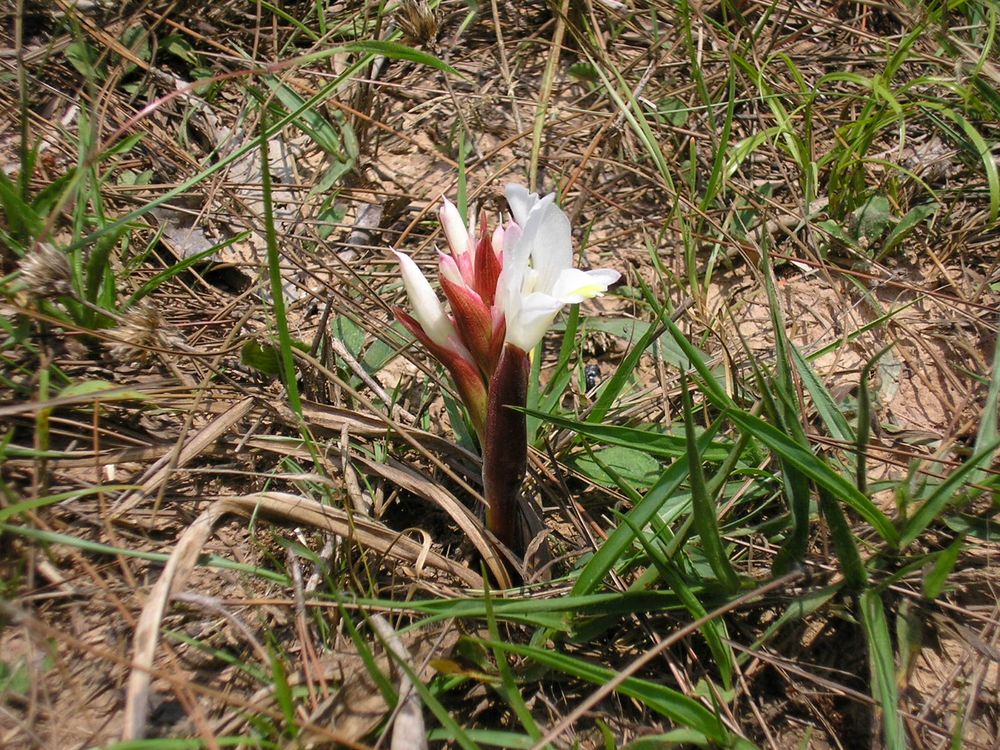
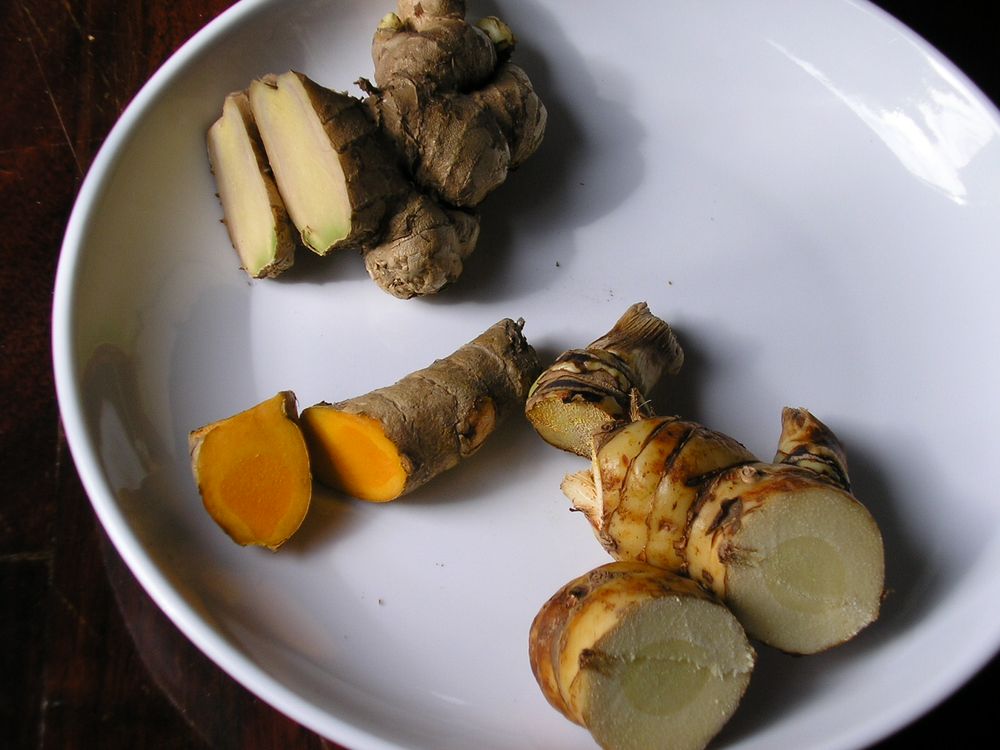
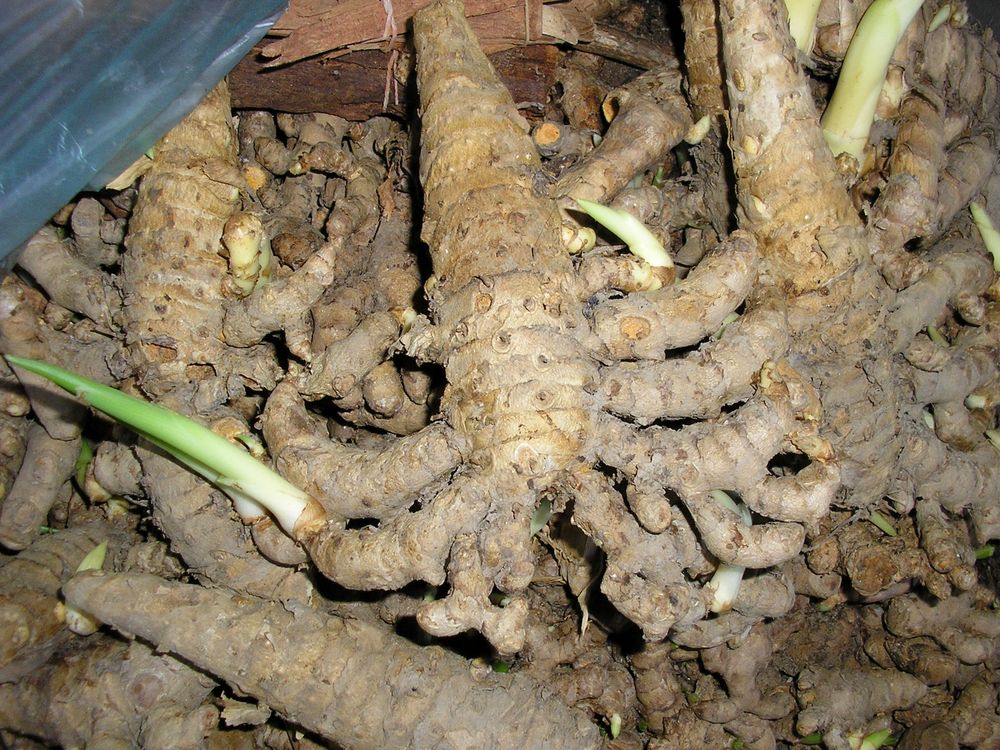
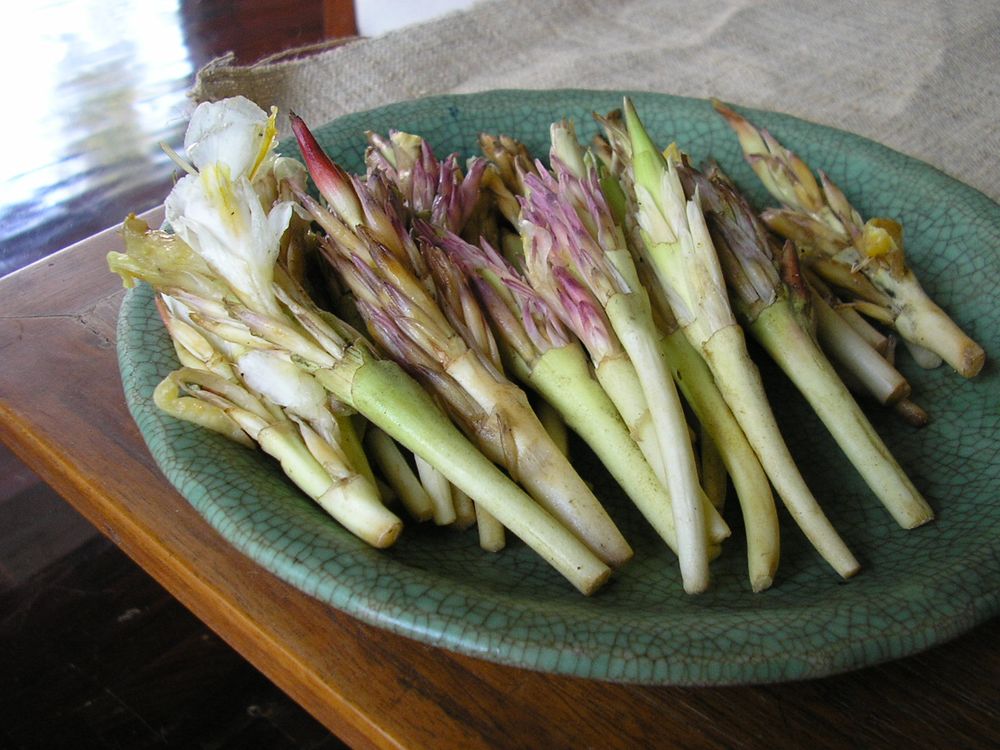
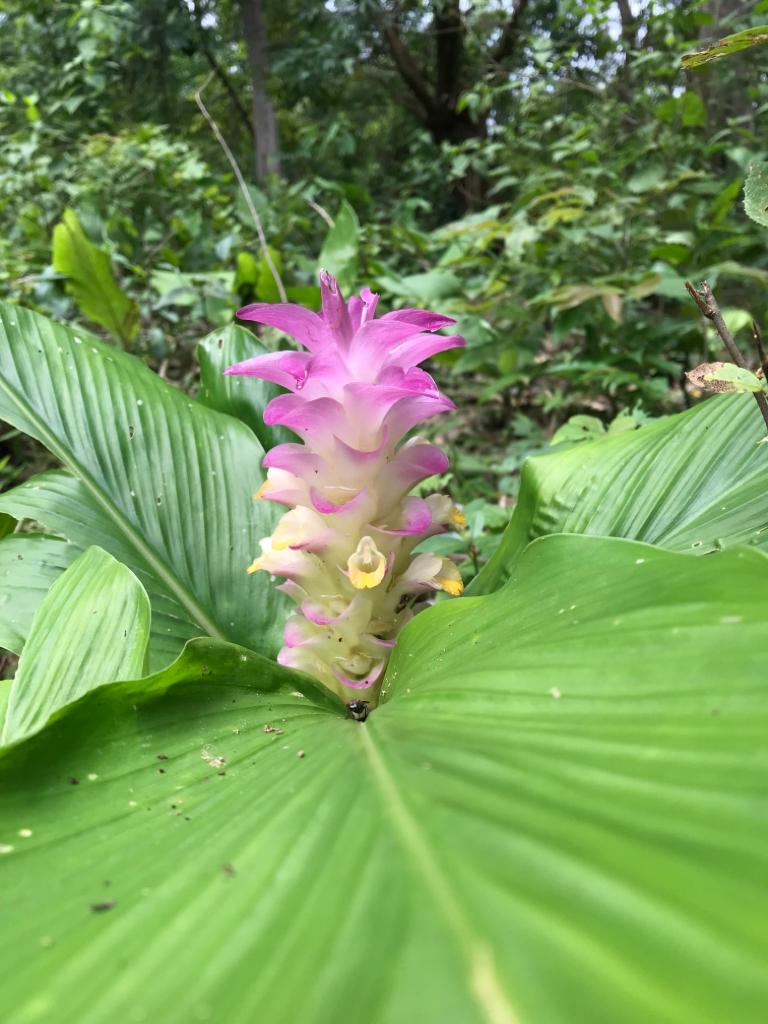
Turmeric originated from India and was quickly cultivated throughout South-east Asia. It is an herbaceous plant of the ginger family, comprised of large, smooth leaves and little yellow or white flowers, often with red spots. It is grown as a spice, a dye, and a medication, but it also has artisan, ritual, and ornamental values.
While ginger and Galangal are first and foremost of all the spices, the turmeric is characterized as much by its aroma as by the yellow-orange color of its rhizome, and it is this characteristic that induced the names that it has been given. “Curcuma” comes from the Arabic, “kourkoum”, which is one of the names, that of “saffron”, which also comes from the Arabic “zafaran”.
Khimin is, therefore, the turmeric or saffron of India. In Laos, however, khimin is a common name, given to diverse plants that produce yellow-coloured growth.
Contrary to the Thai, the Lao do not use the turmeric so much as a spice, but rather they use the rhizome, dried and ground to powder, as one of the ingredients (together with ginger, cardamom, cumin, pimento…) in curry (kali in Lao). With laap, they also eat the flowers (raw) of a species of turmeric, ka tieo.
Associated, in the west, with Indian curries, turmeric is, throughout all of Asia, where the colour yellow is very popular, the plant most used for dyeing purposes. In Buddhism, for example, yellow is omnipresent – however, in the Hindu religion, it is written that the Buddha considered all dyeing to be impure. Nevertheless, his disciples adopted the colour ochre with which the ascetics clothe themselves. It is very simple to make dye from turmeric. One boils the rhizome and, when the water has evaporated, then collects the pigment remaining in the pot. One can also equally use the rhizome powder as a spice as well as a colourant. It should be noted that this pigment is registered as a food colouring agent by the CEE, under the code: E100; one finds it in mustards, in margarine…
When looking for turmeric in the market, do not look near the stalls selling vegetables and condiments, where you find Ginger and Galangal, because khiminh is sold alongside products relating to rituals. In point of fact, the water brought to the temple for use in ceremonial purification rites, is perfumed and/or coloured by a few slices of turmeric. It is likely that the yellow colour of the water is more significant in the rites than the aroma, which is provided by other plants. One also knows of the importance placed on coloured water used in ceremonial rites in India.
In traditional medicine, one uses the turmeric rhizome, as well as that of other numerous varieties found in the forests of the region, to treat stomach upsets and heal wounds. In the traditional Laotian craft industry, the turmeric rhizome serves as an indicator of salt content, in particular in wall-coverings, because if salts are present, its colour changes to red.
Le curcuma originaire d’Inde, a été cultivé très tôt dans tout le Sud-est asiatique. C’est une plante herbacée de la famille du gingembre donnant de très grandes feuilles lisses et de petites fleurs jaunes ou blanches souvent tachées de rouge. Il est cultivé comme épice, teinture et médicament mais il a aussi une fonction artisanale, rituelle, ornementale.
Alors que le gingembre et le galanga sont avant tout des épices, le curcuma est caractérisé autant par son arôme que par la couleur jaune orangé de son rhizome, c’est ce caractère qui induit les noms qu’on lui donne. « curcuma » vient de l’arabe « kourkoum » qui est l’un des noms du safran, lequel « safran » vient aussi de l’arabe « za-faran ».
Khimin est donc le curcuma ou safran des Indes. En lao, d’ailleurs, « khimin » est un nom commun à diverses plantes donnant des produits de couleur jaune.
Les Lao n’utilisent pas directement le curcuma en tant qu’épice contrairement aux Thaï, mais ils le font indirectement puisque ce rhizome, séché et réduit en poudre est l’un des composants (avec le gingembre, la cardamome, le cumin, le piment…) du curry ou cary (kali en lao). Ils mangent également crues, avec le lap, les fleurs d’une espèce de curcuma, ka tièo.
Associé en Occident aux currys hindous, le curcuma est aussi la plante tinctoriale la plus utilisée dans toute l’Asie où la couleur jaune est très recherchée. Dans le bouddhisme, d’évidence, le jaune est omniprésent et pourtant le Bouddha, comme dans la tradition hindoue, considérait toute teinture comme impure. Cependant ses disciples adoptèrent la couleur ocre dont se vêtaient les ascètes. La teinture au curcuma est très simple, il suffit de faire bouillir pendant un certain temps le rhizome, une fois l’eau évaporée on recueille le pigment au fond du récipient; on peut aussi utiliser la poudre obtenu à partir du rhizome qui sert aussi bien d’épice que de colorant. A noter que ce pigment est enregistré comme colorant alimentaire par la CEE sous le code E100, on le retrouve dans les moutardes, la margarine…
Si vous cherchez du curcuma au marché, n’allez pas vers les étals de légumes et condiments où vous trouvez gingembre et galanga, car khiminh est vendu avec les produits rituels. En effet l’eau lustrale apportée à la pagode est parfumée et/ou colorée avec quelques tranches de curcuma. Il est probable que c’est le jaune de l’eau, ainsi colorée, qui importe dans le rite plus que l’arôme qui est déjà apporté par d’autres plantes; on sait aussi la place que tiennent les eaux colorées dans les rites en Inde.
En médecine traditionnelle on utilise le rhizome de curcuma et celui d’autres variétés, qui sont nombreuses dans les forêts de la région, en particulier pour soigner les maux d’estomac et cicatriser les blessures. Dans l’artisanat traditionnel au Laos, le rhizome de curcuma sert d’indicateur de salinité, en particulier pour les enduits muraux, car il vire au rouge en présence de sels.










Turmeric originated from India and was quickly cultivated throughout South-east Asia. It is an herbaceous plant of the ginger family, comprised of large, smooth leaves and little yellow or white flowers, often with red spots. It is grown as a spice, a dye, and a medication, but it also has artisan, ritual, and ornamental values.
While ginger and Galangal are first and foremost of all the spices, the turmeric is characterized as much by its aroma as by the yellow-orange color of its rhizome, and it is this characteristic that induced the names that it has been given. “Curcuma” comes from the Arabic, “kourkoum”, which is one of the names, that of “saffron”, which also comes from the Arabic “zafaran”.
Khimin is, therefore, the turmeric or saffron of India. In Laos, however, khimin is a common name, given to diverse plants that produce yellow-coloured growth.
Contrary to the Thai, the Lao do not use the turmeric so much as a spice, but rather they use the rhizome, dried and ground to powder, as one of the ingredients (together with ginger, cardamom, cumin, pimento…) in curry (kali in Lao). With laap, they also eat the flowers (raw) of a species of turmeric, ka tieo.
Associated, in the west, with Indian curries, turmeric is, throughout all of Asia, where the colour yellow is very popular, the plant most used for dyeing purposes. In Buddhism, for example, yellow is omnipresent – however, in the Hindu religion, it is written that the Buddha considered all dyeing to be impure. Nevertheless, his disciples adopted the colour ochre with which the ascetics clothe themselves. It is very simple to make dye from turmeric. One boils the rhizome and, when the water has evaporated, then collects the pigment remaining in the pot. One can also equally use the rhizome powder as a spice as well as a colourant. It should be noted that this pigment is registered as a food colouring agent by the CEE, under the code: E100; one finds it in mustards, in margarine…
When looking for turmeric in the market, do not look near the stalls selling vegetables and condiments, where you find Ginger and Galangal, because khiminh is sold alongside products relating to rituals. In point of fact, the water brought to the temple for use in ceremonial purification rites, is perfumed and/or coloured by a few slices of turmeric. It is likely that the yellow colour of the water is more significant in the rites than the aroma, which is provided by other plants. One also knows of the importance placed on coloured water used in ceremonial rites in India.
In traditional medicine, one uses the turmeric rhizome, as well as that of other numerous varieties found in the forests of the region, to treat stomach upsets and heal wounds. In the traditional Laotian craft industry, the turmeric rhizome serves as an indicator of salt content, in particular in wall-coverings, because if salts are present, its colour changes to red.
Le curcuma originaire d’Inde, a été cultivé très tôt dans tout le Sud-est asiatique. C’est une plante herbacée de la famille du gingembre donnant de très grandes feuilles lisses et de petites fleurs jaunes ou blanches souvent tachées de rouge. Il est cultivé comme épice, teinture et médicament mais il a aussi une fonction artisanale, rituelle, ornementale.
Alors que le gingembre et le galanga sont avant tout des épices, le curcuma est caractérisé autant par son arôme que par la couleur jaune orangé de son rhizome, c’est ce caractère qui induit les noms qu’on lui donne. « curcuma » vient de l’arabe « kourkoum » qui est l’un des noms du safran, lequel « safran » vient aussi de l’arabe « za-faran ».
Khimin est donc le curcuma ou safran des Indes. En lao, d’ailleurs, « khimin » est un nom commun à diverses plantes donnant des produits de couleur jaune.
Les Lao n’utilisent pas directement le curcuma en tant qu’épice contrairement aux Thaï, mais ils le font indirectement puisque ce rhizome, séché et réduit en poudre est l’un des composants (avec le gingembre, la cardamome, le cumin, le piment…) du curry ou cary (kali en lao). Ils mangent également crues, avec le lap, les fleurs d’une espèce de curcuma, ka tièo.
Associé en Occident aux currys hindous, le curcuma est aussi la plante tinctoriale la plus utilisée dans toute l’Asie où la couleur jaune est très recherchée. Dans le bouddhisme, d’évidence, le jaune est omniprésent et pourtant le Bouddha, comme dans la tradition hindoue, considérait toute teinture comme impure. Cependant ses disciples adoptèrent la couleur ocre dont se vêtaient les ascètes. La teinture au curcuma est très simple, il suffit de faire bouillir pendant un certain temps le rhizome, une fois l’eau évaporée on recueille le pigment au fond du récipient; on peut aussi utiliser la poudre obtenu à partir du rhizome qui sert aussi bien d’épice que de colorant. A noter que ce pigment est enregistré comme colorant alimentaire par la CEE sous le code E100, on le retrouve dans les moutardes, la margarine…
Si vous cherchez du curcuma au marché, n’allez pas vers les étals de légumes et condiments où vous trouvez gingembre et galanga, car khiminh est vendu avec les produits rituels. En effet l’eau lustrale apportée à la pagode est parfumée et/ou colorée avec quelques tranches de curcuma. Il est probable que c’est le jaune de l’eau, ainsi colorée, qui importe dans le rite plus que l’arôme qui est déjà apporté par d’autres plantes; on sait aussi la place que tiennent les eaux colorées dans les rites en Inde.
En médecine traditionnelle on utilise le rhizome de curcuma et celui d’autres variétés, qui sont nombreuses dans les forêts de la région, en particulier pour soigner les maux d’estomac et cicatriser les blessures. Dans l’artisanat traditionnel au Laos, le rhizome de curcuma sert d’indicateur de salinité, en particulier pour les enduits muraux, car il vire au rouge en présence de sels.


